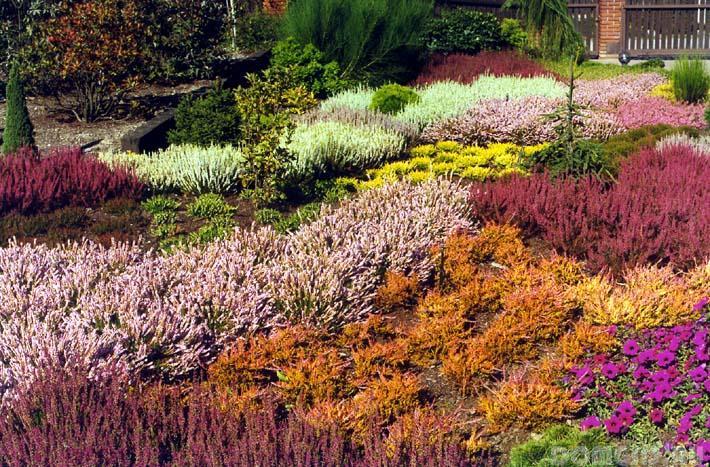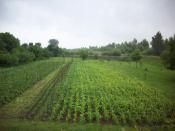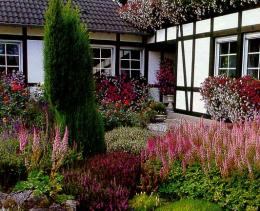Search
Login
Ornamental and medicinal plants on the site. Heather: planting, care and pest protection
If you believe the Scottish legend, heather is the only plant that agreed to grow at the request of the Almighty on the most uncomfortable slopes, blown by the winds. Because heather did not disobey him, God awarded the plant of extraordinary beauty with flowers with a wonderful aroma, amazing vitality and natural charm.
Content
- Ling video
- Habitat
- The basic principles of successful cultivation
- Landing
- Heather - plant care
- Plant propagation
- Bush pruning
- Preparing for the winter
- Heather in garden design video video
- Beneficial features
- Diseases and Pests
Ling

Sung by Scottish poets, the heather ordinary is a low shrub with original tetrahedral leaves. Its height can reach from 25 cm to 1 m. In nature, there are several varieties, they differ from each other in leaf color from silver and yellow to bronze and brown. Each branch ends with a racemose inflorescence with flowers of white, pink, lilac, cherry shades. Shrubs begin to bloom in July, the flowering period is long, the flowers at its end remain on the branches, the plants look like they bloom until winter. Erica, the closest relative of heather, begins to bloom in late autumn.
Plant habitat

Heather - a plant quite common in Europe, Siberia, the Azores and Morocco, in western North America. it was most likely brought to America by Scottish sailors. Most often heather thickets are found in the most difficult climatic places: on wastelands, peatlands, mountain slopes.
The Scots reverently treat this amazing shrub - the dye produced from its leaves was used to paint the famous scotch, from which kilts were sewn. Strong Scottish beer was also made from heather, the first memory of this drink dates back to the 2nd century BC.
Although the genus consists of only one species - the Scottish, it has many varieties. Heather is also often called the Erica plant, which is very similar to it.
Key principles for successful heather cultivation
Growing can be done indoors and outdoors, choosing the right plant for you will not be difficult: today several hundred varieties are known, of which about 50 are suitable for cultivation in the Russian climate.

Although the plant is not capricious, but in order for it to take root in the area you need, you will have to create conditions that are acceptable for it, close to natural. As the first condition should be called acidic, marshy soil.
Heather planting
A transplant is recommended in late spring or early fall. It is advisable to fill the pits for planting with horse peat, if it is impossible to get it - prepare a mixture of peat, sand, fallen needles or sawdust (3: 1: 2). Sulfur (100 g per cubic meter of soil) and conventional mineral fertilizers can be added to the mixture. The latter can also be scattered around the bush - over time, they will dissolve.
A distinctive feature of heather is a very weak root system. Its short roots are not able to extract a sufficient amount of moisture from alkaline soil. When planting, you need to straighten the roots of the plant horizontally - the seedlings grown in the pot will not be able to do this on their own.

A pit for planting is made with a depth of about 30 cm, the distance between the bushes should reach 50 cm. Too close planting will cause the roots of different plants to weave.
Heather - plant care

We have already mentioned that conditions close to natural can be considered ideal for growing heather: acidic soils, good illuminated area, abundance of moisture with good soil permeability. High humidity is especially important for plants that are planted from pots - their root system is very small.
If heather is grown in areas where severe winters are observed, then the soil before the first frosts should be thoroughly moistened. In addition, additional shelter of bushes with spruce branches may be required.
Mulching the site can be done with needles or sawdust, chopped wood bark, leaf humus. Mulch will help maintain moisture in the soil and will suppress weed seedlings in the area. Special fertilizing during the growth of the bush is not required - because in nature it survives on very poor soils.
The key to successful cultivation will be abundant soil moisture. It is advisable to add to the water in small doses of acid: oxalic, citric, apple cider vinegar. Watering is carried out once a week, in especially hot weather - as the soil dries up. Mulching will help to retain moisture, the mulch layer can reach 5 cm. Mulch will also enrich the soil near the bushes with acid components.
Plant propagation

For breeding, usually use the creation air lay. To do this, choose a sufficiently long branch, adjoin it to the ground with a hairpin, fill the place of abutment with soil. It takes a couple of months to create a good root system. Then the mother branch is cut, a new bush is dug up and planted in a permanent place. Young plants should be systematically watered, especially in dry and hot weather.
Plant propagation by seeds and cuttings is possible. These methods are somewhat more complicated than creating layering. They will require patience and a caring attitude to the process. Grow seedlings from seeds possible throughout the year, naturally in a room or greenhouse. Soil temperature should reach +20 degrees. Planting soil: a mixture of peat, sand and coniferous land. Seeds are laid out on the surface of the soil and are not planted. The top of the pot is covered with glass, before emergence. The soil is well moistened, especially during the first 10 days after sowing. Shoots grow slowly, they can be transplanted after 8 months.
Cuttings involves cutting shoots of the strongest, but those that did not bloom. Cuttings are rooted in containers with a sand-peat mixture. Soil requires constant loosening and moistening. The optimum temperature is from +15 to +20 degrees. Cuttings grow more actively than seedlings; they bloom earlier.
The easiest way if you want to get a new plant split up root of an adult bush. The resulting bushes should be well watered and systematically fed.
Bush pruning
To form a bush, annual pruning of plants will be required. It is produced after the flowers have dried. It is advisable to perform this procedure before the start of active plant growth. Timely pruning:
- preserves the beauty of the bush,
- prevents his aging
- provides more active flowering for the next year.
Only the non-woody, green part of the branches is trimmed. If you cut the heather to the level of wood - the plant will not be able to form new shoots and will dry up. Pruning of branches should be done asymmetrically and at different levels - all the beauty of heather lies in a carelessly, chaotically formed crown.
How to prepare heather for wintering
If heathers growing in natural conditions are distinguished by strength, then their decorative garden counterparts need protection from the cold. After waiting for frosts, cover the bushes with burlap and overlay them with spruce branches. After a successful wintering, you will need to remove all dead branches. Shelter plants before the onset of frost should not be.
You can plant bushes after they reach the age of two. Heather, planting and care for which was carried out correctly, will be able to live in your garden for at least half a century.
Heather in garden design

To truly appreciate the beauty of this plant and its usefulness in creating a landscape park, professionals and amateurs involved in creating interesting compositions from decorative plants will be able to: it attracts the opportunity to take advantage of numerous varieties that differ in shape and size, shade of leaves and flowers. A composition of heather of different varieties can make up a very picturesque and vibrant picture. Such a flower bed can be located in a brightly lit or slightly shaded area.
The best neighbors of heather in the flower beds will be rhododendrons, other acitophiles, who also prefer to grow on acidic soils and undersized conifers.
Heather attracts the attention of amateur gardeners in this world with a variety of forms and their unpredictability, a long period of unusually beautiful flowering.

Groups of bushes look great in any garden style. Heather very organically fits into the rockery: intricate bushes against the background of laconic stones look simply amazing. Since heather is able to quickly cover the ground with a continuous carpet, it is often used as a flowering groundcover.

Heather looks very decorative not only from the spring-summer period, but also in autumn, when its leaves acquire yellow-crimson hues and give elegance to the whole garden.
In addition to planting in open ground, heather is grown in flowerpots and used for landscaping terraces and balconies, residential premises.
Useful properties of the plant

- In addition to aesthetic pleasure, heather plantations bring practical benefits: they are an excellent honey plant. Heather honey is very healthy, beekeepers appreciate it for its original aroma.
- Harvested twigs and inflorescences used in the winter for the preparation of cold tea.
- Infusion of twigs helps get rid of allergies, insomnia, diseases of the gastrointestinal tract.
- The healing effect is possessed by baths with a decoction of the inflorescences of the plant.
Diseases and pests of heather

Although the plant is able to survive in harsh conditions in the wild, it needs the protection of man and his care. To prevent infection with a spider mite, it should be done preventative spraying shrubs with chemicals.
Heather is not particularly susceptible to common plant diseases. However, all representatives of this genus can seriously suffer from late blight, which is manifested initially by the appearance of gray plaque on the leaves, the further spread of the disease on the stem leads to the death of the plant. For prevention, it is necessary to ensure the density of the bush that is optimal for ventilation.
When growing heather in a residential environment, placement of pots with plants on drafts should be avoided, but in the warmer months they can be taken out onto open balconies or terraces.





